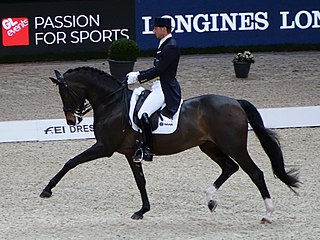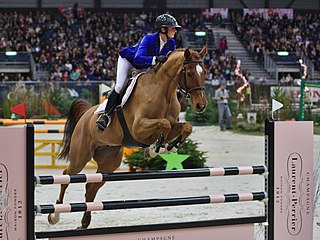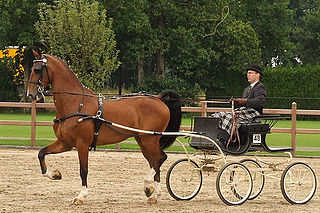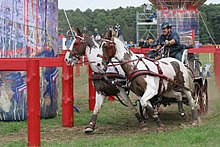
The Groninger or Groningen is a Dutch horse breed developed for light draft and agricultural work. It is closely related to heavy warmblood breeds like the East Friesian and Alt-Oldenburger. The breed was nearly lost in the mid-20th century because a significant number of mares were used for crossbreeding to create the Dutch Warmblood, leaving few purebreds.

The Friesian is a horse breed originating in Friesland in north Netherlands. The breed nearly became extinct on more than one occasion. It is classified as a light draught horse, and the modern day Friesian horse is used for riding and driving. The Friesian horse is most known for its all-black coat colour, its long flowing mane and tail, feathering on its legs, a high head carriage, and high stepping action.

A Dutch Warmblood or KWPN is a horse breed of warmblood type registered with the Royal Warmblood Studbook of the Netherlands [Koninklijk Warmbloed Paardenstamboek Nederland] (KWPN), which governs the breeding of competitive dressage and show jumping horses, as well as the show harness horse and Gelderlander, and a hunter studbook in North America. Developed through a breeding program that began in the 1960s, the Dutch Warmbloods are some of the most successful competition horses developed in postwar Europe.

The Ukrainian Riding Horse or Ukrainian Saddle Horse is a modern Ukrainian breed of warmblood sport horse. Breeding began in the years after the Second World War at the stud farm of Dnipropetrovsk in central Ukraine – at that time in the USSR – and later expanded to three other state stud farms. It derives from cross-breeding of Hanoverian, Thoroughbred and Trakehner stallions with local mares or with Hungarian Furioso, Gidran Arab or Nonius mares. It incorporates the last bloodlines of the extinct Orlov-Rostopchin or Russian Saddle Horse. It was bred to compete in show jumping, three-day eventing and dressage, but is also suitable as a general riding horse.

The Knabstrupper or Knabstrup is a Danish breed of warmblood horse. It is principally a riding horse, but is also used as a harness horse and as a circus animal. It is broadly similar to the Frederiksborger, but often has a spotted coat. In the past, injudicious breeding for this characteristic alone compromised its constitution and conformation. In the years after the Second World War the mechanisation of agriculture led to a sharp fall in numbers, and by the 1960s no more than 100 of the horses remained. In the twenty-first century it is an endangered breed, with a world-wide population estimated at little over 2000.

The Czech Warmblood, Czech: Český Teplokrevník, is a modern Czech breed of warmblood sport horse.

The Danish Warmblood or Dansk Varmblod is a Danish breed of modern sport horse, established in the mid-twentieth century and used mainly for dressage and show-jumping. Like other European warmblood breeds, it is a performance breed: any suitable horse of any origin may be admitted if it passes a strict performance test. Hanoverian, Holsteiner, Swedish Warmblood and Trakehner are among those that have contributed to the breed.

The Swedish Warmblood is a Swedish breed of warmblood horse. It was originally bred as a cavalry horse at the Strömsholm, Ottenby and Flyinge studs. In the twentieth century it became a general-purpose riding and sport horse. It performs well in dressage, show-jumping and three-day eventing, and also as a harness horse.

The Swiss Warmblood or Schweizer Warmblut is a modern Swiss breed of warmblood sport horse. It was created in the mid-twentieth century by merger of the Einsiedler – which had been bred for centuries at the Benedictine Monastery of Einsiedeln in the Canton of Schwyz – with the Swiss Halfblood and with traditional local breeds including the Ajoie, the Erlenbacher and the Entlebucher. It is sometimes known as the Neue Einsiedler. The Swiss Warmblood is bred at the Haras National Suisse at Avenches, in the Canton of Vaud.

The Latvian Horse is a purpose-bred warmblood horse breed from Latvia. Breeding began in Latvia in the early twentieth century, and a herd book was established in 1927. The breed was officially recognised in 1952. There are two types, sometimes called the Latvian Harness Horse and the Latvian Riding Horse. The harness type was predominant until about 1960, when demand for sport horses increased and more of the saddle type were bred.

The Dutch Draft, Dutch: 'Nederlands Trekpaard', is a Dutch breed of heavy draft horse. It is of cold-blood type, massively built and calm in temperament; it has good stamina. It was bred in the early twentieth century in the province of Zeeland, and may for that reason be known as the Zeeland Horse or Dutch: 'Zeeuws Paard'. It derives from cross-breeding of local Zeeland mares with the Belgian Ardennes and Brabant breeds, to which it is very similar.

The heavy warmbloods are a group of horse breeds primarily from continental Europe. The title includes the Ostfriesen and Alt-Oldenburger ("Old-Oldenburger"), Groningen, and similar horses from Silesia, Saxony-Thuringia, and Bavaria. Breeds like the Hungarian Nonius, Kladruber, and Cleveland Bay are also often classed as "heavy warmbloods." They are the ancestors of the modern warmbloods, and are typically bred by preservation groups to fit the pre-World War I model of the all-purpose utility horse. Unlike the registries of the sport horses that followed them, many heavy warmblood registries maintain closed or partly closed studbooks. However, external evaluation and performance testing of the breeding stock is still a key element in these registries. Many of the heavy warmbloods are selected primarily for family-friendly temperaments.

The Dutch Harness Horse, or Tuigpaard, is a warmblood breed of fine driving horse that has been developed in the Netherlands since the end of World War II. Their studbook is kept by the Koninklijk Warmbloed Paardenstamboek Nederland or KWPN. The breed is based on the native Groningen and Gelderland horses, which were formerly indispensable in agriculture and transportation services. Strict selection procedures and a clear breeding aim enabled breeders to produce a refined, high-stepping horse within a few decades. While with 40 sires and fewer than 2,000 broodmares the population is not large, Dutch Harness Horses are highly recognizable. In the past few years, a handful have come to North America, where they are used as sport horses and saddle seat horses alike.

The Rottaler is a German breed of riding and carriage horse of heavy warmblood type. The name derives from that of the Rottal, the valley of the Rott in the Landkreis of Rottal-Inn in south-eastern Bavaria. It is critically endangered. The Bavarian Warmblood derives from it.
The Vlaamperd is a South African breed of light draught or harness horse; it is also suitable for riding and is used in dressage. It was bred in the Western Cape region of South Africa in the early twentieth century, and resulted from cross-breeding of local mares with imported European stallions, particularly Friesians. The horses are usually black, though mares may be dark seal brown. A stud-book was started in 1983.

The Belgian Sport Horse, Dutch: Belgisch Sportpaard, French: Cheval de Sport Belge, is a Belgian breed of warmblood sport horse. It is one of three Belgian warmblood breeds or stud-books, the others being the Belgian Warmblood and the Zangersheide. It is bred for dressage, for show-jumping and for three-day eventing.

The Zangersheide is a Belgian breed or stud-book of warmblood sport horses. It is one of three Belgian warmblood breeds or stud-books, the others being the Belgian Sport Horse and the Belgian Warmblood.

The Einsiedler or Einsiedeln is a historic Swiss population or breed of warmblood horse with roots going back to the eleventh century. It was – and still is – bred at the Benedictine Abbey of Einsiedeln in the Canton of Schwyz, and is sometimes known as the Cavallo della Madonna. In the mid-twentieth century the stud-book was discontinued and the Einsiedler was merged with the Swiss Halfblood and with traditional local breeds including the Ajoie, the Erlenbacher and the Entlebucher to create the Swiss Warmblood, a modern sport horse. Although it is reported to be extinct, the traditional type is still bred at the abbey; there are perhaps a hundred of them in all, with fewer than ten foals born each year.

The Polish Half-bred or Polish Noble Half-bred, Polish: Polski koń szlachetny półkrwi, is a modern Polish breed of warmblood sport horse. Breeding began in the 1960s. Mares of the traditional Polish Malopolski, Wielkopolski and Silesian Warmblood sport horse breeds were crossed with stallions of Western European breeds of established competitive ability. It was bred for competition in dressage, showjumping and eventing, but may also be used for recreational riding or amateur sports. It is one of four warmblood sport horses in Poland.





















